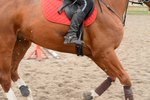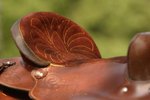
When it comes to horses, it seems as if everyone has an opinion on the right way to do things. The only way to separate useful advice from the rest is to learn the reason behind doing things a certain way, such as mounting and dismounting on a particular side, and decide whether those reasons apply to your situation.
Near Side
The left side, also called the "near side," is considered the proper side for mounting and dismounting a horse. This tradition goes back to the days when horses were used in battle, and the rider's weapon was a sword. A right-handed man carried his sword on his left side, and so he mounted on the left so the sword wouldn't get in the way as he swing his leg across the horse. There were no stirrups in those early days, and so having a full range of movement to mount the horse was critical.
Safety
Horses don't see and think the same way as humans. To a horse, each side of his body essentially has a different experience, and the images he sees with each eye are processed separately. Because of this, a horse may accept being mounted or dismounted from one side but not the other because he has never been taught about the other side. For safety and consistency, horses are traditionally mounted from the left side.
Tack
In keeping with the tradition of mounting from the left, most horse tack, such as cinches, breast collars, bridles and throat latches, is designed to be buckled and fastened on the left side of the horse. This makes it easier to tack up and then mount without constantly moving around the horse. The same is true for dismounting. Tack is designed to be removed from the left side of the horse.
Off Side
The right side of the horse is considered the "off side." Traditionally, very little is done from this side of the horse, since even during saddling and bridling everything is done on the left. Many horse trainers advocate teaching your horse to be saddled and mounted from the right as well as the left, however, as part of developing a well-rounded equine partner. This training allows a rider to mount on the opposite side in case of an emergency, or under unusual circumstances. The process of teaching a horse to allow a rider to mount and dismount from the right must start with very basic steps, as if he were not broken to ride, since for the horse it is an entirely new experience.
References
- The Straight Dope: Why Are Horses Traditionally Mounted from the Left Side?
- Certified Horsemanship Association: Why Do We Mount from the Left Side?
- Rutgers Cooperative Extension: Mounting, Dismounting, and Riding Horses Safely [PDF]
- University of Missouri Extension: Saddling, Bridling and Riding the Western Horse
Photo Credits
-
BananaStock/BananaStock/Getty Images




